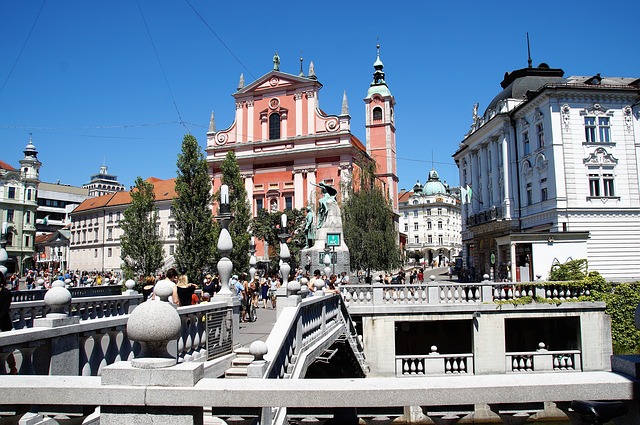By Tim Lambert
Early Slovenia
By about 3,500 BC Stone Age farmers lived in what is now Slovenia. The bronze age followed then about 750 BC the iron age began. Then about 400 BC, the Celts settled in Slovenia. They formed the state of Noricum.
However, in 10 BC the Romans conquered Slovenia. Under Roman rule, Slovenia prospered and towns were founded like Emona (Ljubljana), Celeia (Celje), and Poetovio (Ptuj). However Roman rule collapsed in the 5th century AD.
In the 6th century AD, the Slavs arrived in Slovenia. However in the 8th century, they came under the domination of the Franks of central Europe, and in the 9th century, Slovenia was absorbed into the Holy Roman Empire, which was centered on Germany. Meanwhile, missionaries converted Slovenia to Christianity. In the 10th to 13th centuries, Slovenia remained under German domination.
However, in the early 12th century towns were founded in Slovenia, and trade and commerce flourished. Yet in the 14th century, the Habsburg dynasty came to control Slovenia. The Habsburgs gained Carinthia and Carniola in 1335 and they gained Istria in 1374 and Trieste in 1382.
In the late 15th and 16th centuries, peasants in Slovenia often rebelled. However, all the rebellions failed.
Meanwhile, the Turks threatened Slovenia. However, they were crushed at the battle of Sisak in 1593.
The Reformation also rocked Slovenia. In the early 16th century Protestantism made some headway but by the century’s end, the Catholic Counter-Reformation reconverted Slovenia.
The 18th century was a prosperous time for Slovenia and her industries flourished. In the late 18th century religious freedom was allowed and primary education was made compulsory.
Slovenia in the 19th century and early 20th century
In the 18th century, Slovenia was part of the Austro-Hungarian Empire. However, Napoleon wanted to cut Austria-Hungary off from the sea. So in 1809, he carved out an area he called the Illyrian Provinces. The Slovenian language was used in schools and government. However, in 1814 with the defeat of Napoleon Slovenia was absorbed back into the Austro-Hungarian Empire. Yet in the early 19th century Slovenian literature flourished. The leading figure was France Preseren (1800-1849).
In 1848 Europe was rocked by revolutions. Slovenians demanded an autonomous Slovenia and the use of the Slovenian language in schools and government. The emperor refused but during the late 19th century Slovenes formed political parties. However, they wanted autonomy rather than outright independence. Nevertheless, many Slovenes emigrated in the late 19th century.
Then in 1918 with the end of the First World War, the Austro-Hungarian Empire disintegrated. Slovenes joined with Serbs and Croats to form a new state led by Serbian King Peter I. A Serbian named Stojan Protic became the first prime minister. In 1929 the next king, Alexander made himself an absolute ruler and he renamed the kingdom Yugoslavia. However, he was assassinated in 1934 and his cousin Paul became regent.
In March 1941 the regent signed a treaty with Germany but he was overthrown in a coup. In response, the Germans bombed Belgrade on 6 April 1941 and invaded Yugoslavia. They conquered the country in a matter of days. During the Second World War, Slovene partisans fought the Germans.
However, from 1943, some anti-Communists called the Slovenian Domobranci supported the Germans to prevent the spread of Communism. However, they failed and in May 1945 Slovenia was completely liberated. The Domobranci retreated into Austria where the British disarmed them. However, the anti-Communists were then sent back to Yugoslavia – to their deaths. About 12,000 were killed by the partisans. Following the war, Trieste was placed under Anglo-American control, and in 1954 it was awarded to Italy.
Modern Slovenia
Meanwhile, Slovenia became part of a Communist Yugoslavia led by Tito. Industry developed and living standards rose. However many Slovenes resented the way resources were siphoned off from them and given to less prosperous parts of Yugoslavia.
Tito died in 1980 and in the late 1980s, Yugoslavia began to break up. In Slovenia, opposition parties were formed. In 1989 they published the May Declaration demanding independence and democracy. In April 1990 free elections were held in Slovenia then in December 1990 a referendum was held on the issue of independence. The people were overwhelmingly in favor so on 25 June 1991 the Slovene parliament declared Slovenia independent.
The Yugoslavian army then made a half-hearted attempt to invade Slovenia on 27 June 1991. However, they were held in check by the Slovenian Territorial Defense Forces and the police. On 7 July the Yugoslavs agreed to a ceasefire brokered by the EU.
In December 1991 Slovenia gained a new constitution and on 15 January 1992 Slovenian independence was recognized by the EU. Like many Eastern European countries, Slovenia faced a painful transition from Communism to Capitalism during the 1990s.
However, in 2004 Slovenia became a member of the EU. Also in 2004, Slovenia joined NATO. In 2007 Slovenia joined the Euro.
Slovenia, like the rest of Europe, was affected by the recession of 2009 but it soon recovered. Today its economy is growing steadily. Tourism is a flourishing industry in Slovenia. In 2024 the population of Slovenia was 2.1million.

Last revised 2025